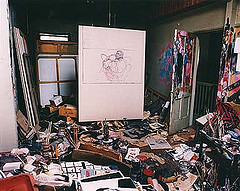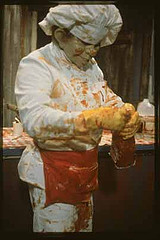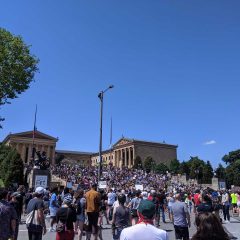Andrea Kirsh reports:
[This is part 2 of Andrea’s report from Dublin. Here’s part 1].

Francis Bacon’s studio, recreated at The Hugh Lane
The other ambitious exhibition that beaconed with work by John Baldessari, Daniel Buren, Bruce Nauman, Martha Rosler, Andy Warhol and others was at Dublin City Gallery The Hugh Lane [ed.: that is the correct name of the place!]. The Studio, organized by the museum’s curator, Christina Kennedy and Jens Hoffman was inspired by the studio of Francis Bacon, which is on permanent view, and predicated on the idea that the concept of the artist’s studio has long captivated audiences. It was also an homage to Daniel Buren’s article, The Function of the Studio (1979), which is to be re-printed in revised form in the exhibition’s catalogue.
Now, the late Francis Bacon’s studio is of interest, if only for its overwhelming chaos and the fact that archaeologists had to be brought in to record the contents before they could be moved from Bacon’s London studio to the museum in Dublin. But I’m not certain that “the studio” in general is of any interest to audiences. Artists are of interest to audiences; most people being more interested in other people than in either art or ideas. In connection with the exhibition, the Dublin City Gallery The Hugh Lane arranged not only lectures, a panel discussion and film screenings but tours of a dozen actual artists’ studios in the Dublin area. I wasn’t able to join a tour, but it is clearly a wonderful and pertinent project that has the added benefit of reminding museum audiences that art exists not only in museums, but artists live all around them and have to work and make art and a living (often not the same thing).
As to the exhibition, it, like the .all hawaii eNtrees/luNar reGGae at IMMA, also suffered too much from ideas, with the works doing little to engage the audience or each other. The best part of it was the clever use of wooden packing crates as bases for video monitors and, in one case, as a long bench where one could sit to watch films (transferred to video) of Andy Warhol and his entourage, working and talking.
The artist, Andrew Grassie had set up a studio in the corner of one exhibition gallery. In a sort of endless circle (with precedents in tromp l’oeil paintings), he had photographed this set-up; he then painted two (out of a proposed four) small images in tempera on board, each of which was very close to each other and, presumabl,y to the photos from which they were made. But I found his virtuosity with paint rather more interesting than the self-referentiality of the concept.

Still from Paul McCarthy’s Painter
Paul McCarthy’s 50-minute video, Painter, takes us through 45 tedious minutes of the clown-nosed artist painting from tubes marked “shit,” up to the denoument, when, out of the studio his dealer presents him to potential patrons, for whom the artist bares his ass so they can smell it. The studio is not really the point here.
Buren’s writing may have had an important place in thinking about artists’ studios since the 1970s, as did his equally-important article on the function of the museum, from 1973; but an exhibition 30 years later is not the best way to explore the legacy of his thought.
–Andrea Kirsh is an art historian living in Philadelphia. See her Philadelphia Introductions essays on emerging artists at inliquid.









